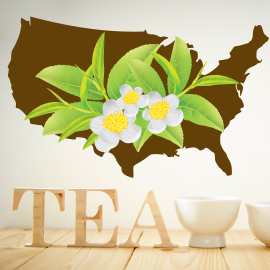 Tea, a beverage loved and cherished by millions around the world, has a fascinating history that spans over 5000 years. Like all camellias, Tea is not native to America. It originated in China, and it is here that the legend of Tea began.
Tea, a beverage loved and cherished by millions around the world, has a fascinating history that spans over 5000 years. Like all camellias, Tea is not native to America. It originated in China, and it is here that the legend of Tea began.
According to ancient legend, an early emperor of China named Shen Nung passed a decree that all drinking water must be boiled as a hygienic precaution. One day, some of the emperor’s servants were boiling water to prepare a drink for the court, when dried leaves of a nearby Tea plant accidentally fell into the boiling. Curious, the emperor decided to taste this new beverage, and to his delight, he enjoyed it so much that it became the drink of choice in ancient ChinaTea continued to be popular in China, and its spread throughout the country was aided by traveling Buddhist priests. One of their journeys brought Tea to Japan, where it became the centerpiece of the famous “Japanese Tea Ceremony,” an art form that celebrates the beauty and simplicity of the Tea-drinking experience.
It wasn’t until the early 1600s that Tea was discovered by Europeans. Initially, its use was restricted to wealthy individuals and nobility due to its high price. Tea was considered a rare and precious spice, with prices exceeding $100.00 per pound in Europe. However, as the craze for Tea swept through China, Japan, and Europe, it became a part of the way of life, particularly in England where “Afternoon Tea” became a ritual.
In the late 1600s, Tea made its way to the colonies in America, where it quickly gained popularity. However, tensions between the colonists and the English started to mount. The English imposed various taxes on the colonists, including the Tea Tax in 1767. This tax proved to be the tipping point for the colonists, who famously protested by dressing up as Indians, boarding ships in New England, and throwing hundreds of pounds of tea into Boston Harbor in an act that became known as “The Boston Tea Party.” This act of defiance played a significant role in propelling America towards independence during the Revolutionary War.
Despite Tea’s popularity in America, attempts to grow it on American soil were initially unsuccessful. The earliest known attempt occurred in 1744 when Tea seeds were sent to Savannah, Georgia but failed to germinate. It wasn’t until 1772 that Tea plants successfully made their way to Georgia, and by 1805, Tea was growing on Skidaway Island near Savannah. However, challenges such as insufficient capital and a malaria epidemic hindered the early efforts to grow Tea in America.
The most successful attempt at growing Tea in America took place around Charleston, South Carolina. Philipe Noisette made one of the first attempts in Charleston in 1813, but like previous efforts, it did not thrive. However, in the late 1800s, Pinehurst Tea Plantation and Golden Grove Tea Company managed to grow Tea in the Charleston area. Although both had disappeared by the early 1900s, in 1960, Tea cultivation was revived in Charleston at a Lipton Research facility on Wadmalaw Island, which later became known as The Charleston Tea Plantation.
America has also introduced two significant innovations in the world of Tea. At the 1904 World’s Fair in St. Louis, on a hot day when no one seemed interested in hot Tea, someone put ice in the Tea by accident. This birthed the beloved American tradition of Iced Tea, which today accounts for 85% of the Tea consumed in America. Additionally, America is credited with inventing the Teabag, a more convenient way to enjoy Tea.
With over 6 billion pounds of Tea produced worldwide each year, Tea has become the second most consumed beverage globally, after is truly remarkable to think that this beloved beverage is made from the camellia plant. The Tea plant not only offers a delightful landscape with its fall and early winter blooms but also the possibility for gardeners to grow their own Tea.
Today, Charleston Tea Plantation and The Great Mississippi Tea Company are two of the largest producers of American Grown Tea. However, smaller farms, homesteads, and gardens across the United States contributing to the growth of the Tea industry. While it remains to be seen whether Tea will become a major agricultural crop in America, the signs are promising.
As we explore the history and impact of Tea on agriculture around the world, it becomes evident that camellias, with their beauty and versatility, offer much more than just pretty flowers. They offer a journey through time, connecting us to ancient legends, cultural traditions, and a beverage that has stood the test of time. So, the next time you enjoy a cup of Tea, remember the fascinating tale that brought it from ancient China to your teacup.





